
2025 Kia Tasman First Off-Road Review
The 2025 Kia Tasman has arrived in Australia, we benchmark its off-road performance, styling, interior features against the Ranger, HiLux, Triton, and more.
B+
UNGRADED

B+
UNGRADED

What people are saying:
Pros
- Great off-road specs
- Class-leading interior
- Clever towing and camera tech
Cons
- Front-end styling won’t appeal to everyone
- Underpowered engine for the price
- No front locking diff
We’ve finally got behind the wheel of the all-new 2025 Kia Tasman — and in top-spec X-Pro form, no less. On paper, it takes aim squarely at the Ford Ranger Wildtrak and Toyota HiLux GR Sport with a hefty price tag and serious off-road credentials.
But does the hardware deliver, and is it ready for Australia’s toughest buyers? We put some - almost production spec - pre-production examples to the test off-road, and have formed some opinions. Let’s elaborate.
How much does the Kia Tasman cost?
The Tasman X-Pro sits at the top of Kia’s new dual-cab ute range, priced at $74,990 before on-road costs. It undercuts the V6-powered Ford Ranger but is still a serious chunk of change.

2025 Kia Tasman Pricing:
Tasman S 4x2 – $42,990
Tasman S 4x4 – $49,990
Tasman SX 4x4 – $54,490
Tasman SX+ 4x4 – $62,390
Tasman X-Line 4x4 – $67,990
Tasman X-Pro 4x4 – $74,990
Note: All prices above exclude on-road costs.
Decidedly Divisive Design
There’s no sugar-coating it: the Tasman’s front-end design will divide opinion. When Kia pulled the covers off the Tasman in Korea, even among international media, the wide-spaced headlights drew a few groans – and they still feel oddly proportioned in person. The way they integrate into the fender flares looks unconventional and may not suit all tastes, especially when paired with a bulbar, which, in my opinion, seems to exaggerate the awkwardness.
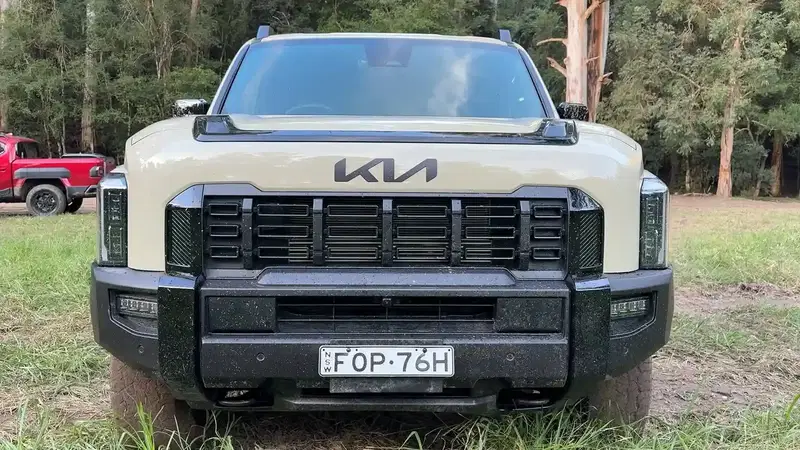
That said, from other angles, the Tasman makes a much stronger case for itself. The side profile looks properly rugged, with high ground clearance and blacked-out cladding that helps the X-Pro trim feel purposeful.

The rear end is arguably the best angle of the vehicle, with bold LED tail-lights, large, debossed Kia badging, and a clean tailgate design that is both modern and functional. I've found it to be a ute that looks better while in motion — preferably fast motion — and out in the wild than it does in press images or showrooms.

Proportions-wise, the Tasman is taller than many of its rivals — standing about 35mm higher than a Ford Ranger, and I noticed it visually towering over a last-gen Mitsubishi Triton when parked side-by-side. That height contributes to a commanding presence on- and off-road, although it also means shorter drivers will likely need side steps – something Kia is still finalising for production models.

Attention to functional design details is clear throughout. There’s a steel bash plate underneath, storage compartments built into the wheel arches, and tough roof rails. However, the vertical angle of the windscreen raises concerns about potential stones flicking up and cracking it. Whether the styling works for you or not, it’s clear that practicality, stance, and going outside the box were high on Kia’s design priorities for the Tasman.



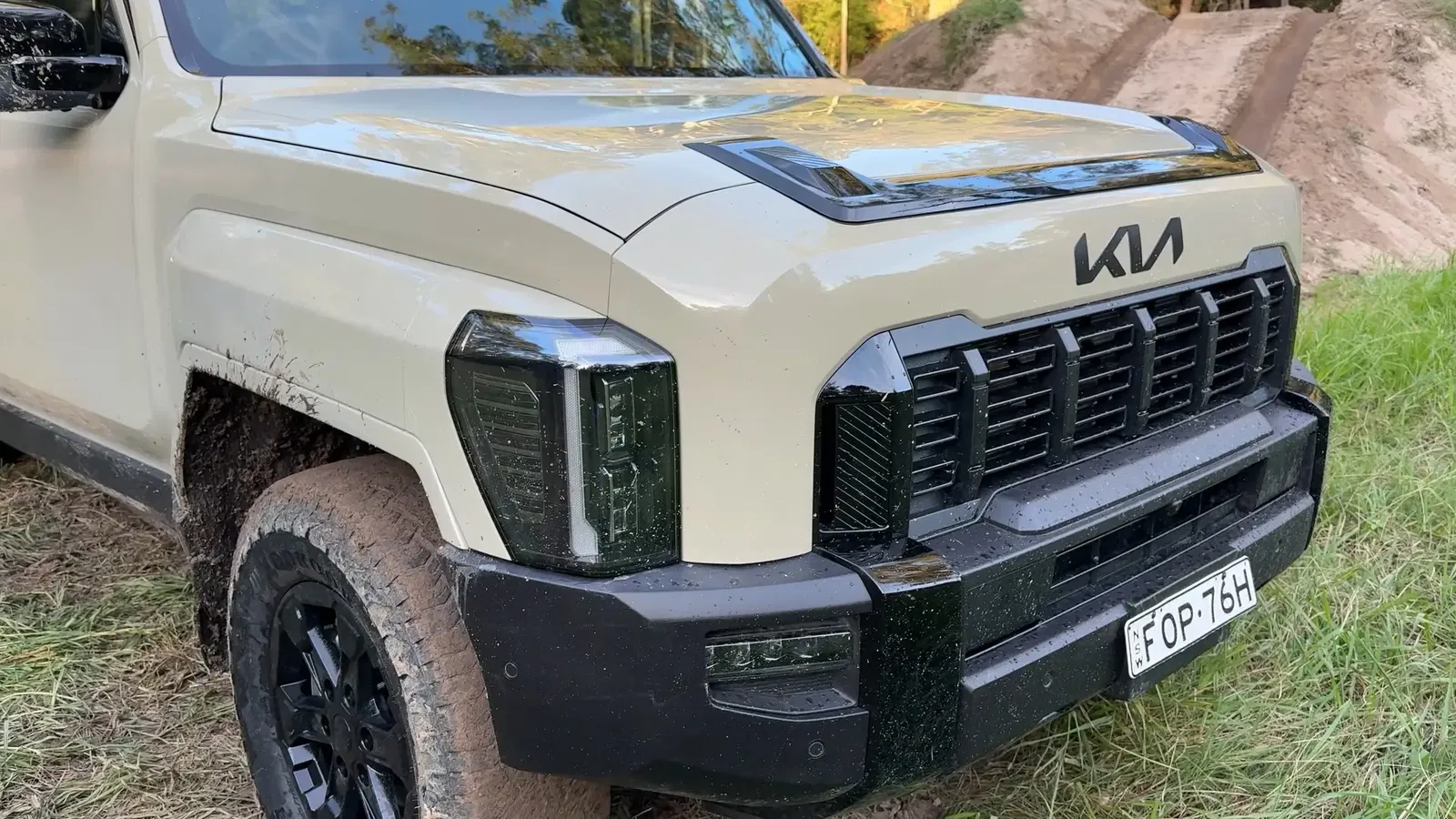
Modern and Feature-Packed
The Tasman's interior is a standout in the segment, blending rugged practicality with a level of premium comfort and technology that we've come to expect from the Korean carmaker. Dominating the dashboard are twin 12.3-inch displays – one for the digital instrument cluster and the other for infotainment. These are crisp, vibrant, and highly responsive, with wireless Apple CarPlay and Android Auto as standard. Physical controls for climate are retained in a neat display sandwiched between the screens, making the cabin easier to use on the move.

Aesthetically, the cabin introduces Kia’s new design language seen on EV models like the EV9. Soft-touch materials are in all the right places and there are thoughtful details like ambient lighting, a stylish steering wheel, and durable finishes on lower surfaces where utes typically get scuffed up. There are two Qi wireless charging pads up front – a segment first – along with multiple USB-C ports, a 12V socket, and ample practical storage. The large centre console opens up to reveal layered compartments, with plenty of room for larger items.

Comfort levels in the X-Pro are impressive, especially for a ute. The seats are not only heated and ventilated but are also electrically adjustable in multiple ways, with lumbar support and memory functions. According to Kia, these seats have been locally developed specifically for Australian buyers, taking into account our climate and body types.
Beyond comfort and tech, there’s some solid off-road functionality integrated into the infotainment system. A dedicated X-Trek controller for adjusting trail cruise speeds, terrain modes for snow, mud, sand and rock, and an Off-Road Command Center that gives real-time data on pitch, roll, steering angle, tyre pressure, battery voltage, and more, are found on the X-Pro and X-Line. The 360-degree camera system includes an underbody view for tricky off-road trails.

All in all, you would be hard-pressed to find a ute that beats the Tasman in terms of interior comfort, features, and technology. Giving it a close run for it's money would be the BYD Shark 6 - with soft leather upholstery, heated and ventilated seats, and a 15-inch touch infotainment system - and of course the venerated Ford Ranger which ruled the segment, unchallenged for years. The Tasman one-ups both of these in terms of overall refinement and design, and that makes it - in my opinion - class-leading.




First-Class Comfort
Rear seat passengers are exceptionally well catered for in the Tasman X-Pro – far more than what we typically see in the dual-cab ute segment. One of the standout features is the ability for the rear seats to slide and recline. It’s not just gimmicky either – the range of motion is generous, and even in the reclined position, legroom remains ample. Combine that with plush leather trim, heating for the outboard seats, and wide headrests, and you’ve got a genuinely premium experience.

Practicality is another area where the rear seats shine. Under the bench is a large, easily accessible storage compartment, ideal for tools or extra gear. Behind the seatbacks, there’s additional flat storage space, though it’s a bit more limited. Thoughtful touches continue with unique storage solutions like a small tray at floor level for items like a phone or snacks, along with dual USB-C ports mounted to the seatbacks. There’s even a 240V household socket offering up to 400W.

Kia has also added clever design elements like zippered storage pockets made from neoprene-style material that looks like wetsuit fabric on the backs of the front seats. The centre armrest folds down to reveal two cup holders, a phone tray, and more soft leather padding. Overall, the back seat of the Tasman feels more like a mid-size SUV than a rugged work ute – and that’s a compliment Kia should be proud of.

Rubba Tub-Tub!
With a tub longer and wider than that of the Ford Ranger, the Kia Tasman X-Pro immediately positions itself as a seriously practical dual-cab ute. Measuring 1512mm in length, 1572mm in width, and offering 1186mm between the wheel arches, the tub is larger in every dimension compared to the Ranger. It’s enough for an Australian and Euro pallet, so it’s more than enough for the average ute customer.

Kia has focussed on making the tub quite user-friendly. A tub liner is standard, along with gas struts for the tailgate, and you also get adjustable tie-down points, and a 400W household power outlet. There’s also a convenient rear step integrated into the bumper which is not found on some rivals.
Kia also promises a suite of factory-backed accessories to further tailor the tub to your lifestyle, including options like a powered roll-top tonneau cover and roof-mounted storage. Combined with its standout payload of around 1000kg and a 3500kg towing capacity, the Tasman’s tub is among the most versatile and capable in the class.

Faithful, Lacking Pizzazz
The 2.2-litre turbo-diesel engine produces 154kW and 440Nm – a familiar unit for Kia, and one that gets the job done in most conditions. Paired with an 8-speed automatic torque converter, the transmission is well-tuned and delivers smooth shifts, especially off-road. Kia’s calibration seems to focus on keeping torque available through a broad rev range, which helps for towing and crawling through difficult terrain. However, when looking at the segment as a whole, the Tasman’s powertrain numbers don't exactly leap off the page at you.

Compared to the Ford Ranger, the Tasman lacks both choice and outright grunt. The Ranger offers a 2.0-litre bi-turbo four-cylinder with 154kW/500Nm – same power, but noticeably more torque – and a 3.0-litre V6 turbo-diesel option that pushes out 184kW and 600Nm, giving it a major advantage for buyers who tow heavy loads or just want more punch on the road. Even the Isuzu D-Max's 3.0-litre four-cylinder diesel, which produces 140kW/450Nm, offers slightly more torque and is proven in tough Aussie conditions.
The Toyota HiLux, depending on spec, uses a 2.8-litre turbo-diesel with 150kW/500Nm, while the newly-updated Mitsubishi Triton makes 150kW/470Nm from its 2.4-litre twin-turbo diesel. Against this backdrop, the Tasman’s engine lands somewhere in the middle of the pack on paper – neither class-leading nor underwhelming, but certainly less than what you’d expect at nearly $75k.
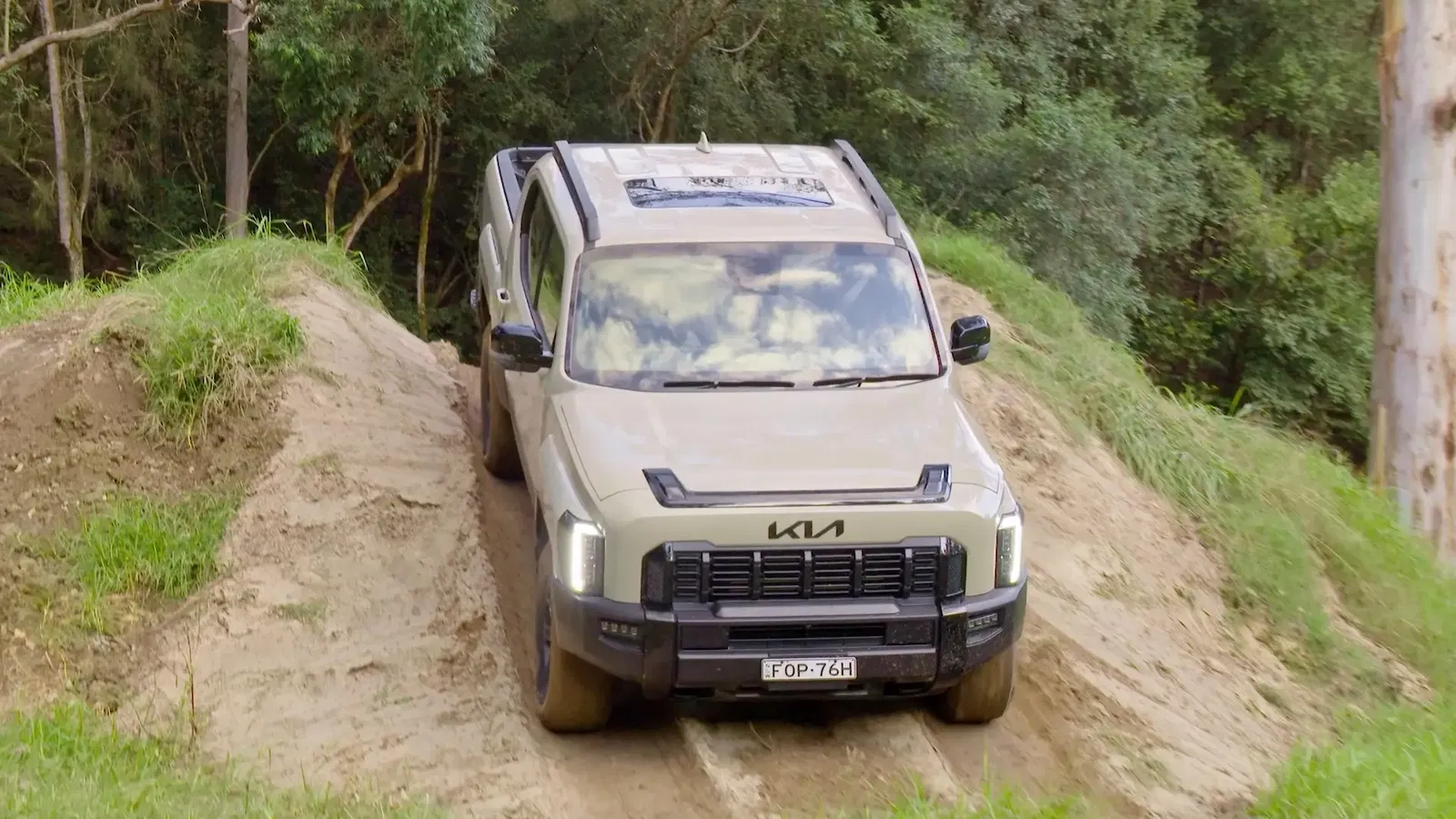
One area that’s harder to evaluate in pre-production form is refinement and long-term durability. Off-road, the Tasman performs confidently and the traction control software fills in well for the absence of a front locking differential. Still, for buyers comparing spec sheets and prioritising performance, the Tasman’s engine and drivetrain may be a sticking point.
The Kia Tows, Man
While this test didn’t extend to on-road towing, Kia has taken towing seriously with the Tasman, especially in the X-Pro variant. Across the entire dual-cab pick-up range, the Tasman is rated to tow up to 3500kg braked, right in line with market leaders like the Ford Ranger and Toyota HiLux. What’s impressive is that this figure holds consistently across both 4x2 and 4x4 variants, without requiring any optional towing packs.
Payload capacities are also strong, with the X-Pro offering just over 1000kg of payload – enough to carry serious gear in the tray while towing. Some models, such as the base 4x2 S, stretch this figure up to 1124kg. Interestingly, Kia also allows buyers to specify a reduced payload option below 1000kg at no cost to help qualify for novated leasing benefits.

The integrated trailer brake controller is standard on all models – a rare inclusion, especially at the lower end of the range. The Tasman also includes multiple trailer brake settings and weight modes to suit different towing setups. The X-Pro goes further with additional cooling hardware for the transmission, including an air-cooled transmission oil cooler and an upgraded fan to support consistent performance under load.
Additionally, towing profiles can be stored and recalled through the infotainment system, allowing you to configure braking force and stability systems for different trailers. Combined with its off-road readiness, 360-degree camera, and advanced drive assistance features, the Tasman proves it's more than ready for serious towing duties.

I Dub Thee: Bushwacker 9000
In X-Pro trim, the Tasman is equipped with a robust suite of off-road gear that positions it as one of the most capable utes in its class. Ground clearance stands at a segment-leading 252mm on OEM-fitted all-terrain tyres, and it's matched with impressive approach and departure angles – 32.2 degrees up front and 26.2 degrees at the rear. The shorter overhangs, high-mounted front bumper, and lifted stance help the Tasman confidently clear rocky inclines and uneven terrain, while an 800mm wading depth puts it on par with the Ford Ranger for water crossings.
Mechanically, the X-Pro benefits from a ladder-frame chassis designed specifically for this platform, paired with high-mount double-wishbone front suspension and a rigid rear axle with leaf springs. Frequency Selective Dampers (FSD) are standard, helping to smooth out corrugations and sudden jolts without compromising stability. Kia also includes a proper locking rear differential, activated via a simple switch, which helps in more technical scenarios. However, there is no front — or centre — diff lock available across the range.

Traction modes are easy to access via the dedicated terrain management system. You get selectable modes for Snow, Mud, Sand, and Rock, along with an X-Trek off-road cruise control function with five selectable speeds. The 17-inch black alloy wheels are wrapped in Hankook Dynapro AT2 Extreme tyres, which offer decent grip and sidewall protection.
The Tasman's Off-Road Command Centre delivers real-time telemetry, including pitch, roll, tyre pressures, oil and transmission temperatures, battery voltage, and even steering angle. These details are displayed in a dedicated off-road screen that can also show the underbody camera view, offering a clear picture of wheel placement when tackling narrow or rocky paths.

Despite being a pre-production vehicle, the Tasman’s NVH performance on rough terrain was notable. It remains quiet inside, with minimal tyre roar or suspension noise coming through the cabin – even on trails littered with loose rock and ruts. The structure feels rigid and the seats remain comfortable through long stretches off tarmac. All up, the X-Pro variant of the Tasman presents a complete off-road package that blends rugged engineering with thoughtful, tech-heavy execution – especially important for weekend adventurers and lifestyle buyers who plan to put their ute to real use.
Safer Than Your Nans Driving
Every Tasman model comes equipped with a solid suite of safety features as standard. Across the range, you’ll find autonomous emergency braking (AEB), adaptive cruise control, trailer sway control, front and rear parking sensors, and a reversing camera. These features offer buyers a strong safety baseline even at the entry level.
Higher-grade models build on this foundation with more advanced driver assistance technologies. The SX introduces Highway Driving Assist 2, which includes lane-centring assist and navigation-linked adaptive cruise control. This system also supports automated lane changes on certain roads, which is rare for this class. SX+ and X-Line further expand on these inclusions, adding blind-spot monitoring and cameras, along with a 360-degree view monitor that significantly improves visibility when parking or manoeuvring off-road.

ANCAP safety testing is still pending for the Tasman, but Kia has a strong recent track record in crash performance. Given its equipment list and structural engineering focus, a high rating is expected once official testing is completed.
Tasman Safety Feature Breakdown by Grade:
S:
- AEB (forward)
- Adaptive cruise control
- Trailer sway control
- Dual-zone climate control
- Reversing camera
SX (adds over S):
- Adds Highway Driving Assist 2
- Navigation-linked adaptive cruise control
- Lane centring assist
SX+ (adds over SX):
- Adds blind-spot monitoring
- Blind-spot view camera
- Rear cross-traffic alert
X-Line (adds over SX+):
- Adds 360-degree view camera system
- Remote Smart Parking Assist
X-Pro (adds over X-Pro):
- Underbody and surround-view camera
- Off-road safety telemetry
- Memory driver's seat with safety recall

What do you get with the Kia Tasman?
The Tasman lineup is split across five trim levels, each increasing in comfort, capability, and technology. Even the entry-level S variant includes a solid baseline of equipment, while the top-spec X-Pro throws in a host of off-road-focused hardware and premium touches.
Tasman S kicks off the range with:
- 17-inch black steel wheels with a full-size spare
- LED reflector headlights
- Dual 12.3-inch digital displays (infotainment and instrument cluster)
- Wireless Apple CarPlay and Android Auto
- Adaptive cruise control
- Dual-zone climate control with a dedicated climate display
- Trailer brake controller (integrated)
- Mechanical rear differential lock (4x4 variants)
- Cloth seats and keyless start
Tasman SX builds on that with:
- 17-inch alloy wheels
- Power-folding side mirrors
- Satellite navigation with traffic data
- Highway Driving Assist 2 (lane centring + auto lane change)
- Navigation-linked adaptive cruise control
- Enhanced terrain modes: Snow, Mud and Sand
Tasman SX+ enhances comfort and utility further:
- 18-inch alloy wheels
- Cloth and leather-effect seat upholstery
- Single wireless phone charger
- LED fog lamps
- Ambient lighting in the cabin
- Rear seat air vents
- Tub liner and dual 240V power outlets (tray and cabin)
Tasman X-Line brings in luxury and smart tech:
- LED projector headlights
- Sliding and reclining rear seats
- Dual wireless charging pads
- Blind-spot cameras and 360-degree surround view system
- Eight-way power driver's seat
- Synthetic leather-look trim
- Heated front seats and rear centre armrest
- Remote Smart Parking Assist and privacy glass
Tasman X-Pro is the flagship off-road model:
- 17-inch black alloys fitted with Hankook all-terrain tyres
- Manually switchable locking rear differential
- Off-Road Pages for pitch, roll, and system readouts
- Dedicated X-Trek mode and Rock terrain setting
- Harman Kardon premium audio system
- Sunroof, heated rear seats, full ambient lighting
- Eight-way electric front seats with memory function
- Fuel tank and transmission underbody protection

Final thoughts on the Kia Tasman
The 2025 Kia Tasman is a compelling new entry in Australia’s fiercely competitive dual-cab ute market. Kia has delivered a vehicle with definite strengths: excellent off-road capability, clever technology integration, and a standout interior that blends SUV-like comfort with serious utility. Buyers looking for a ute that’s packed with practical inclusions, segment-first features, and bold - albeit questionable - design choices will find plenty to like in the Tasman.

However, it’s not without compromise. The single 2.2-litre turbo-diesel engine, while capable, lacks the torque and power offered by key rivals like the Ford Ranger V6, Toyota HiLux GR Sport, and even the Mitsubishi Triton. This could be a sticking point for those regularly towing heavy loads or chasing maximum performance. The absence of a front diff lock across the range, and the polarising front-end styling, may also deter traditionalists or off-road purists.

Still, where the Tasman makes a strong case is in its premium value proposition. The X-Pro in particular undercuts some flagship rivals while offering comparable – and in some cases better – features, such as dual wireless chargers, reclining rear seats, and a high level of off-road tech. Against something like an Isuzu D-Max or Toyota HiLux SR5, the Tasman brings better refinement and more tech for the money, though it falls short of the Ford Ranger’s powertrains and established reputation.

If Kia delivers its expected seven-year warranty and backs it with competitive servicing, the Tasman will no doubt be a serious player in the segment. It may not reach the status of Ranger or HiLux, but for buyers seeking a fresh, modern ute with plenty of kit and proven off-road credentials, the Tasman is well worth a look.

Saucey rating breakdown
Saucey rating breakdown
FAQ
What engine is in the 2025 Kia Tasman?
All models use a 2.2-litre four-cylinder turbo-diesel producing 154kW and 440Nm.
Can the Tasman tow 3500kg?
Yes, the entire range is rated to tow up to 3500kg braked.
When will the Kia Tasman be available in Australia?
Dual-cab variants arrive in July 2025, with chassis cab versions following later in the year.
Sign up to our newsletter
Be the first to know when we drop new car reviews.
.avif)

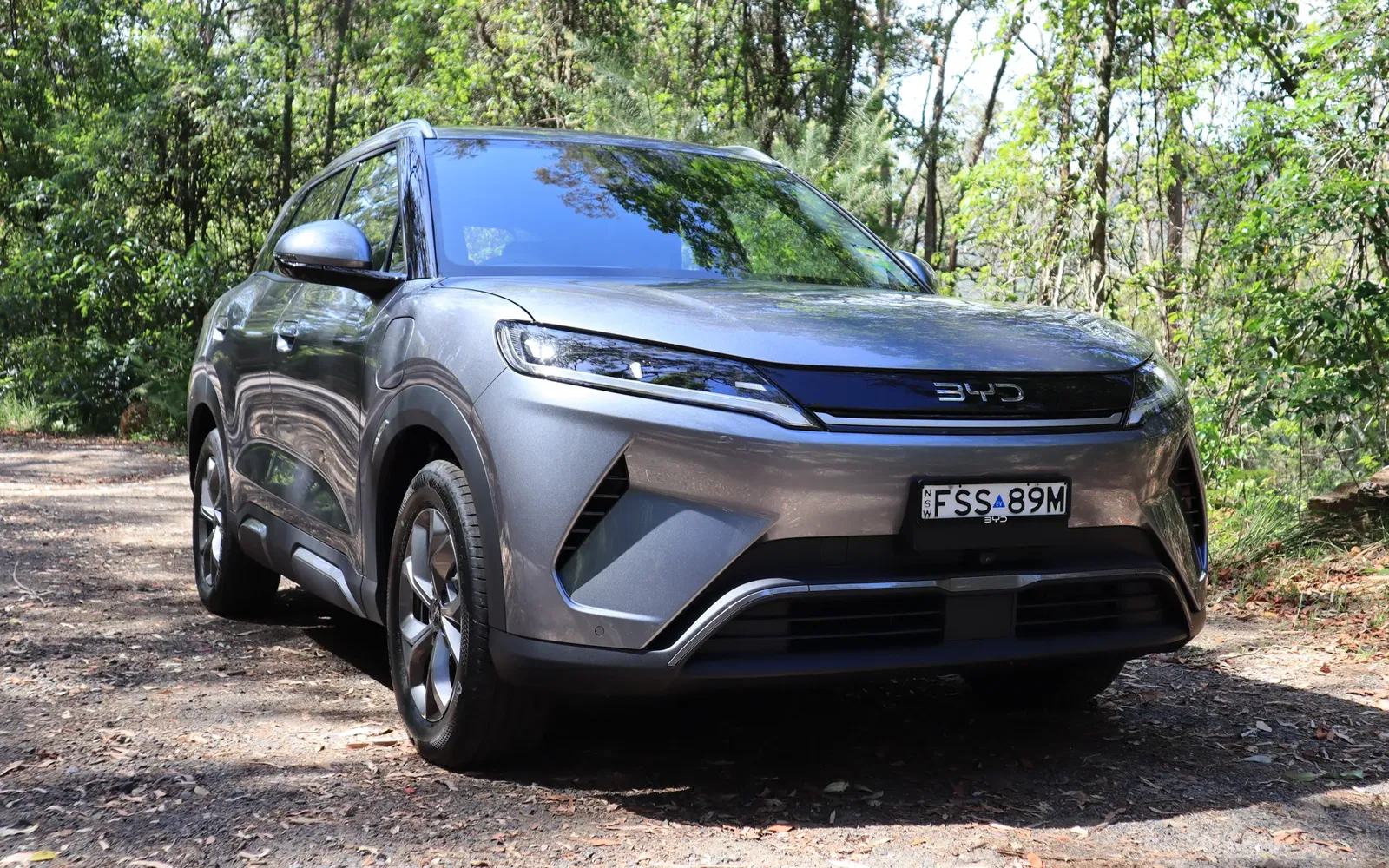

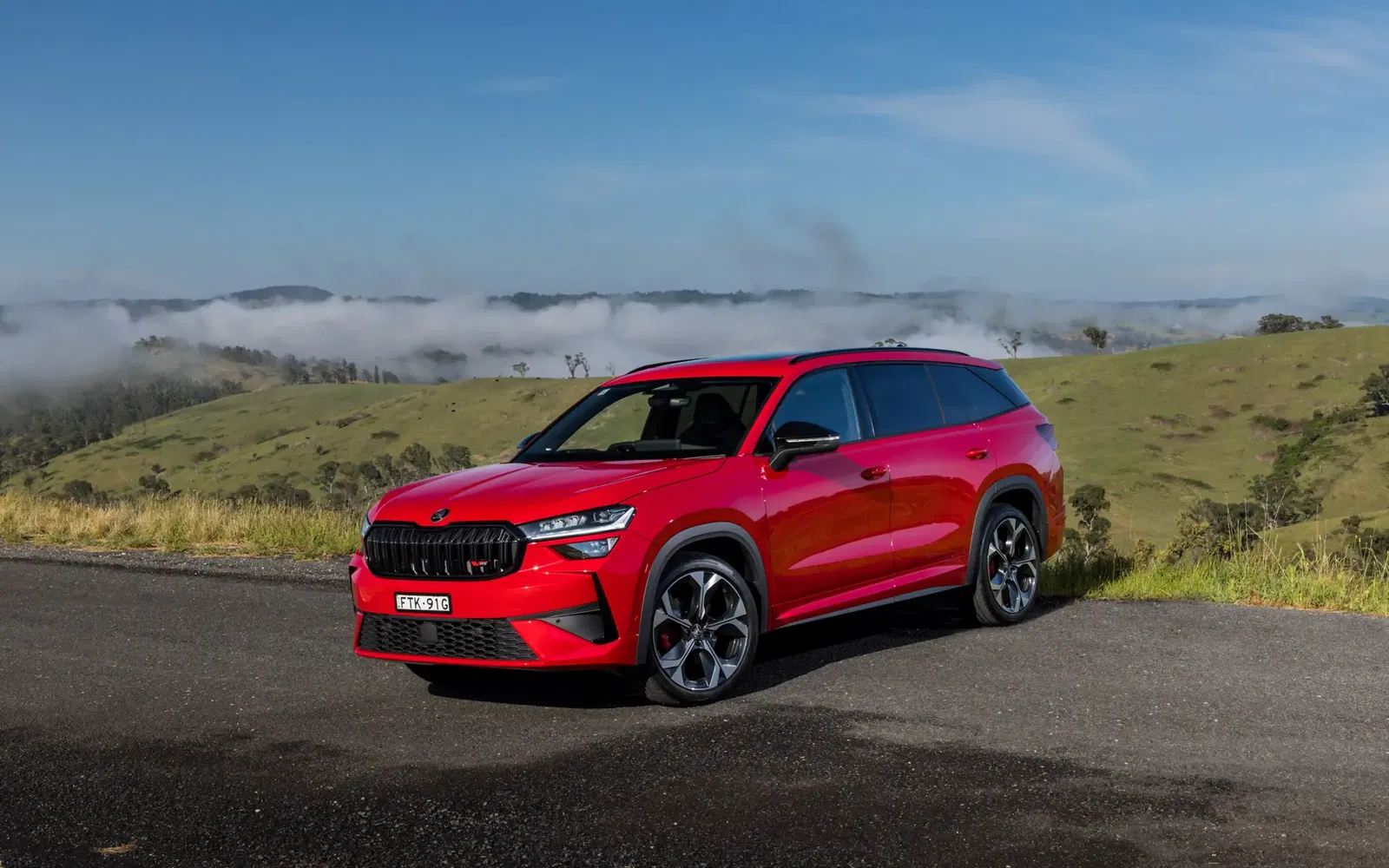
%20Calligraphy%20-%2003.webp)